

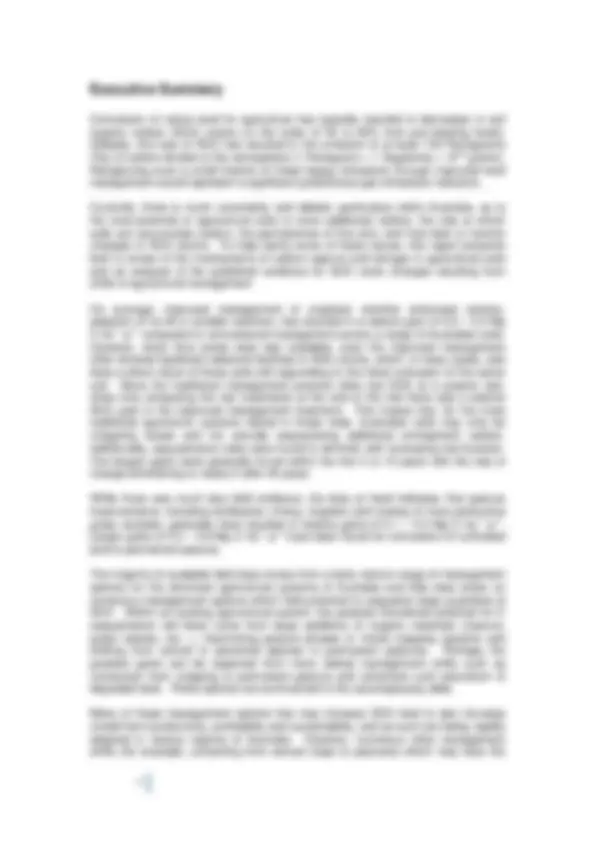
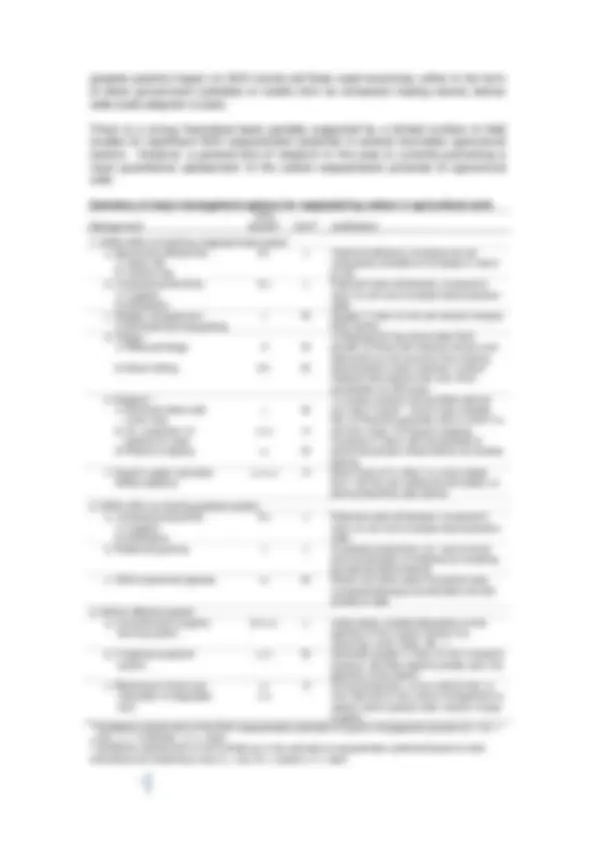

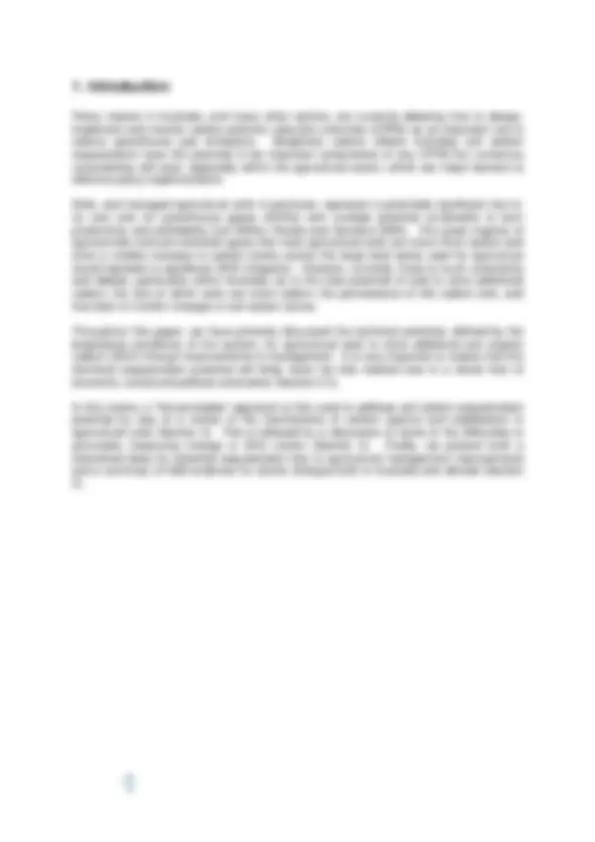
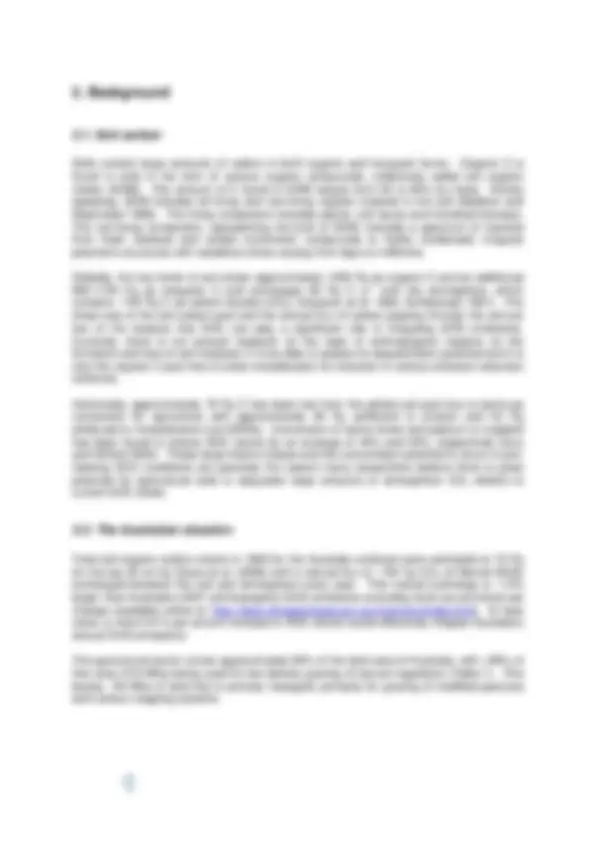
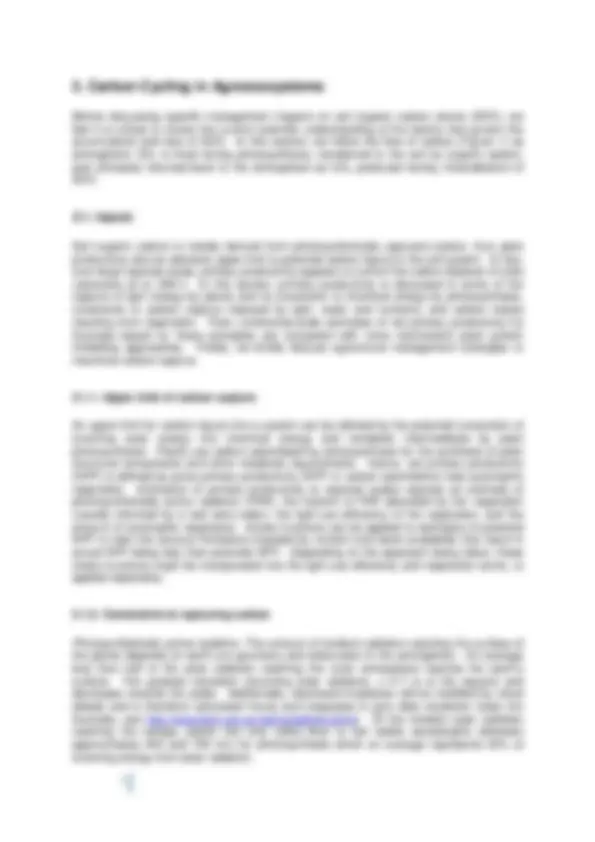
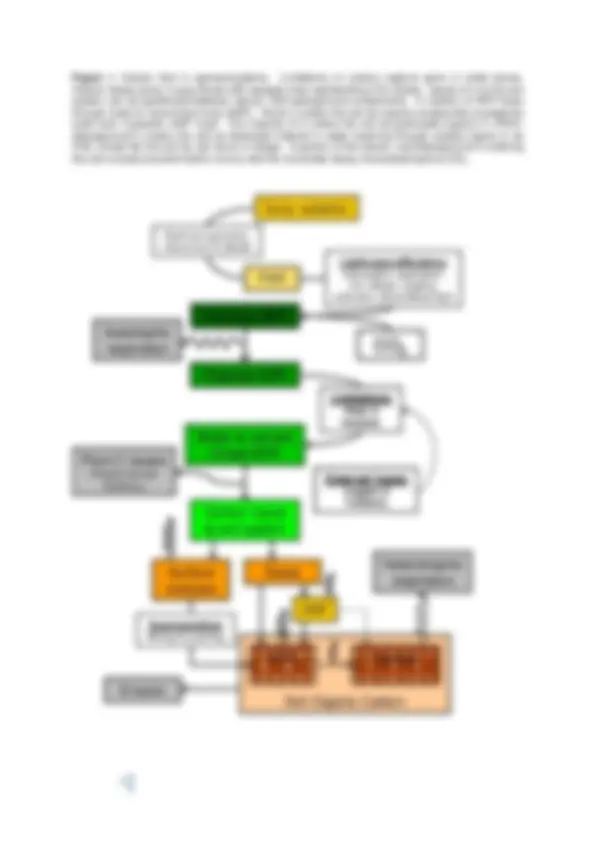
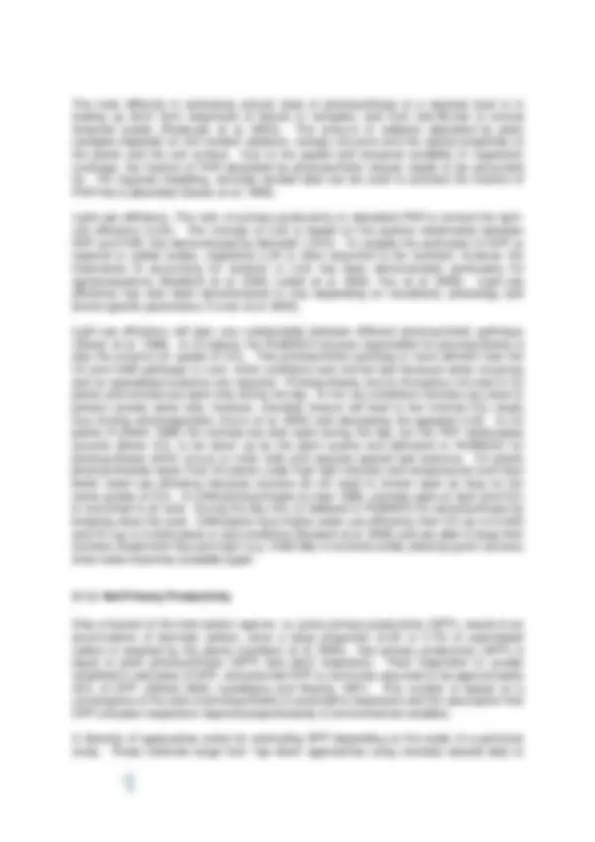
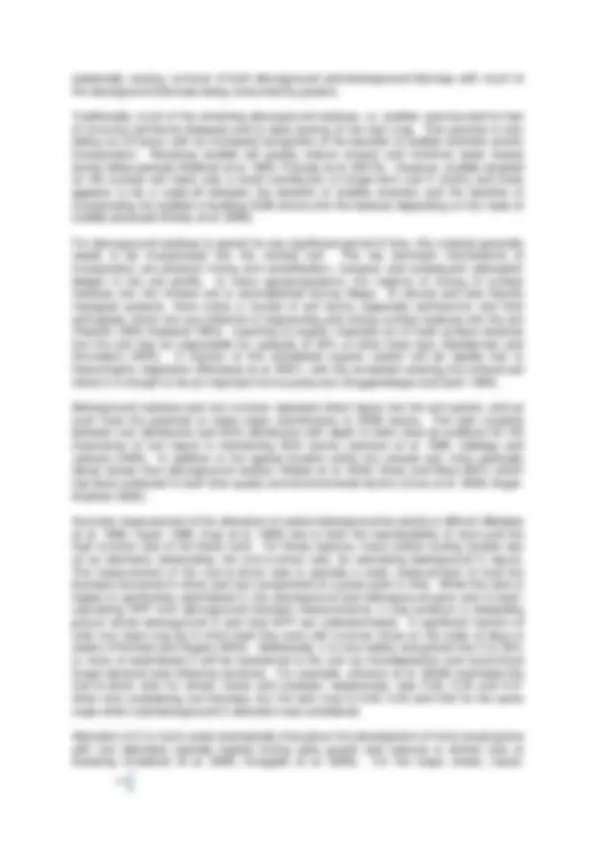
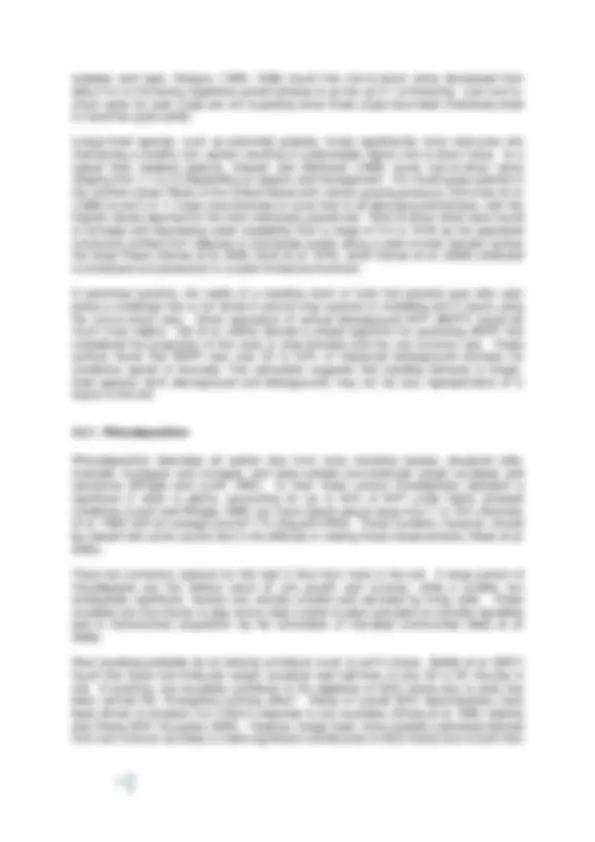
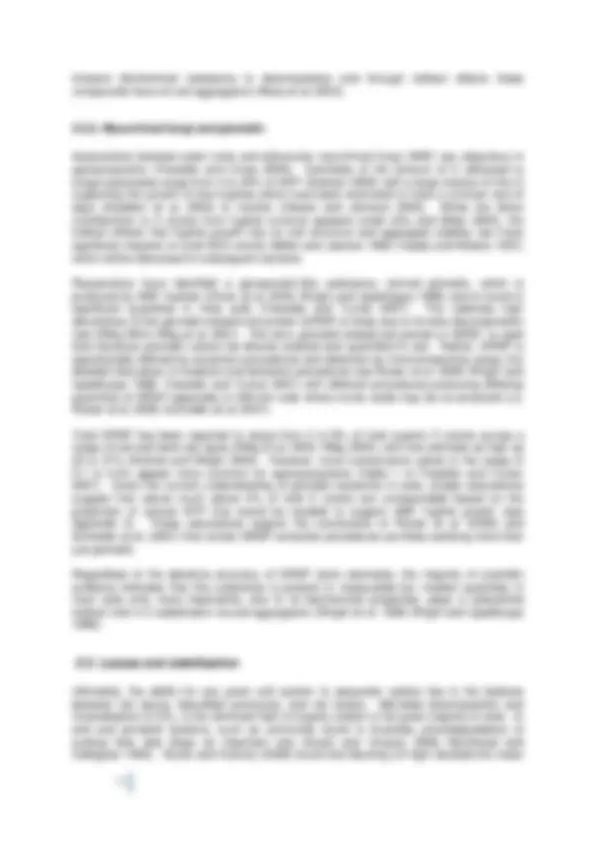
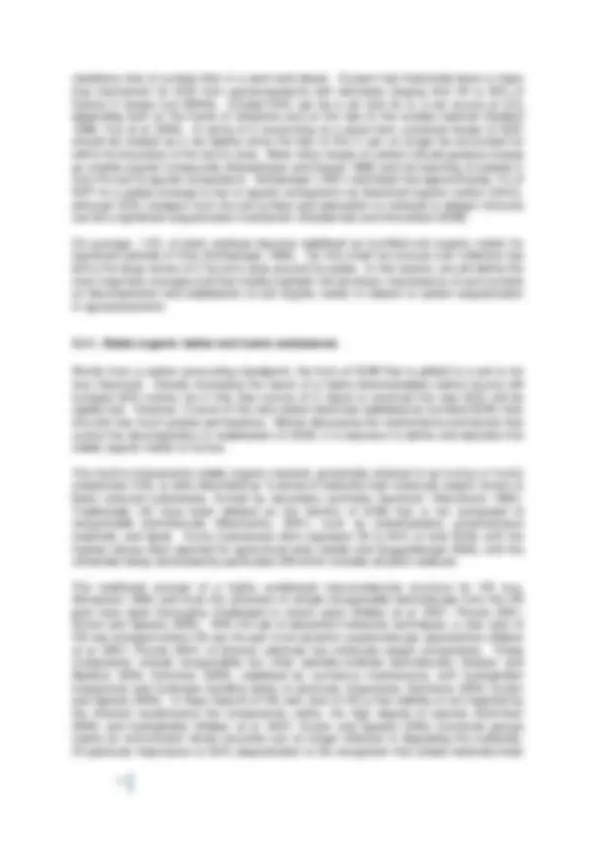
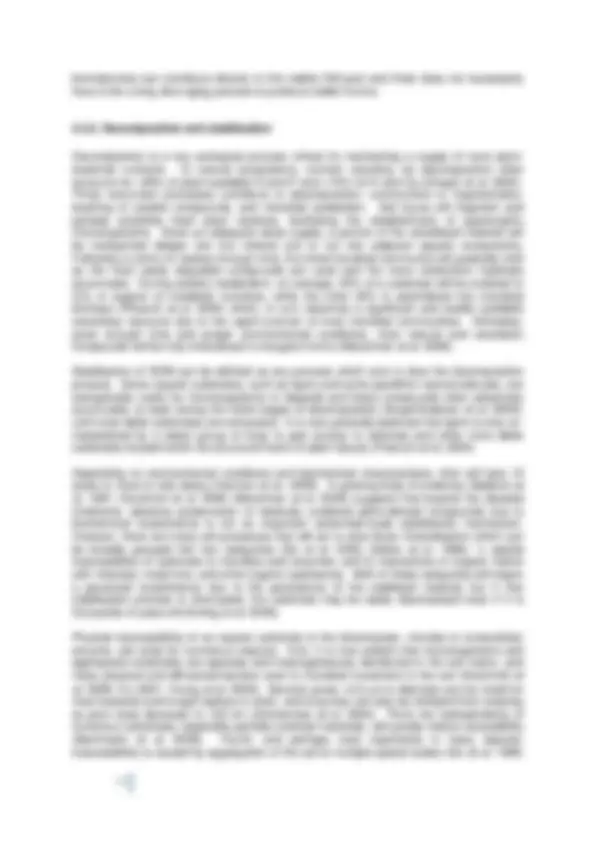
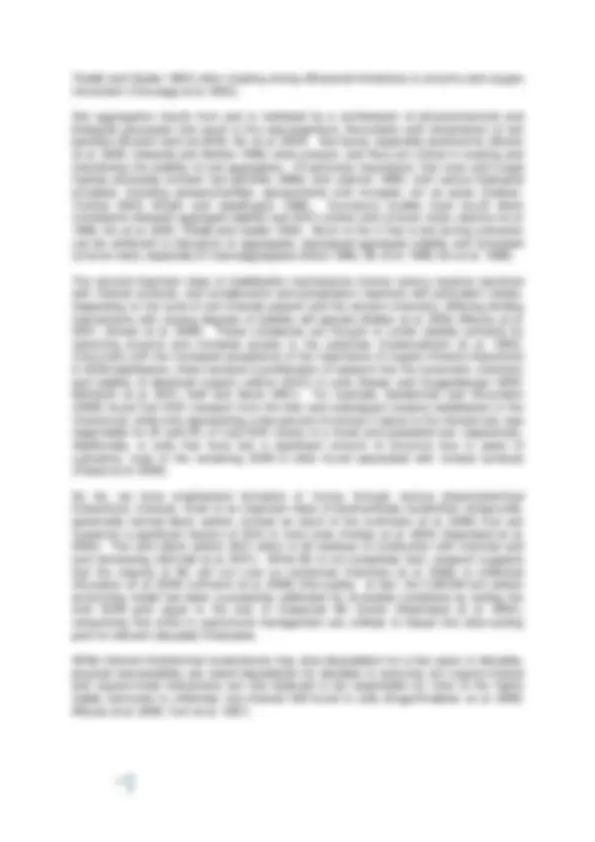
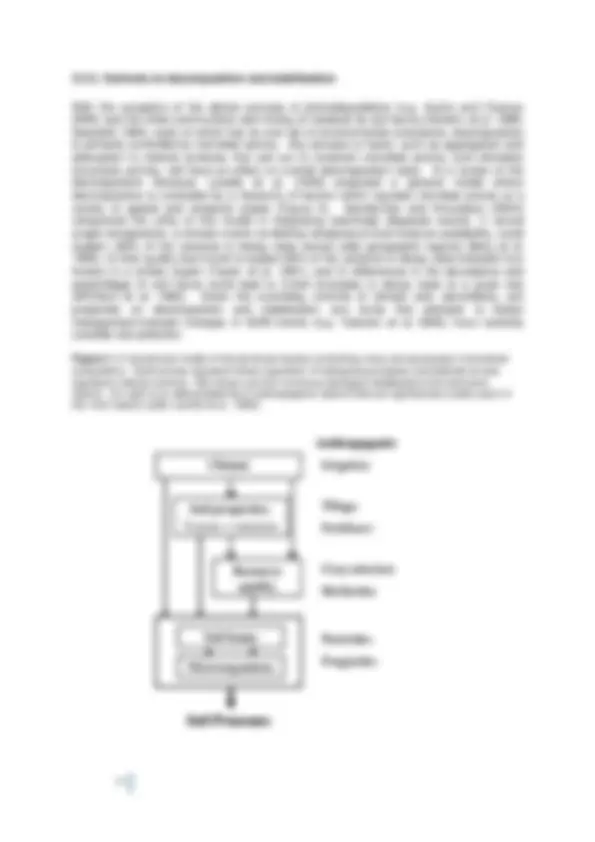
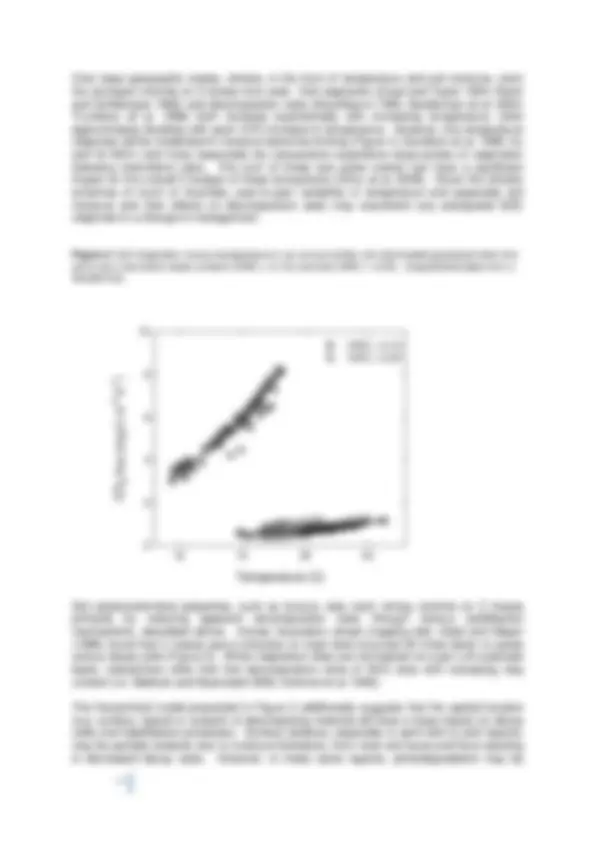
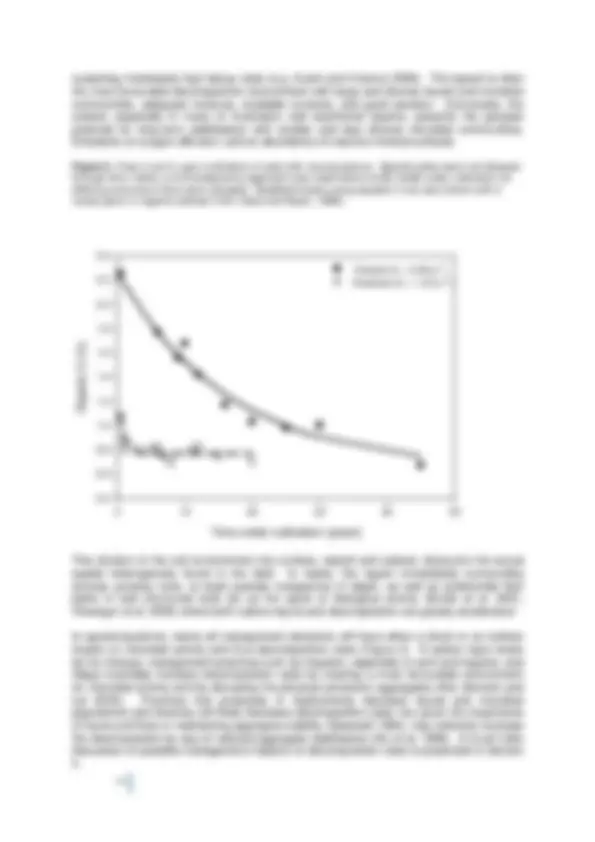
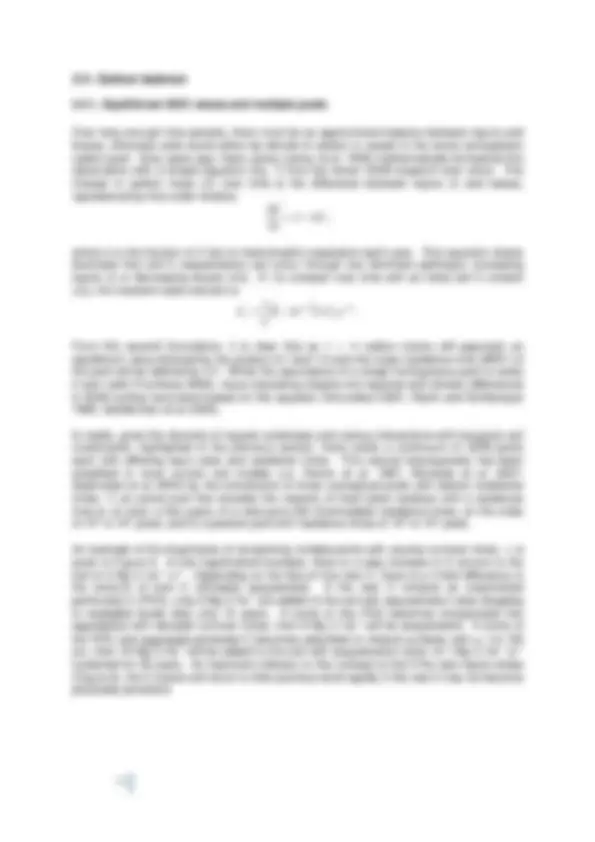
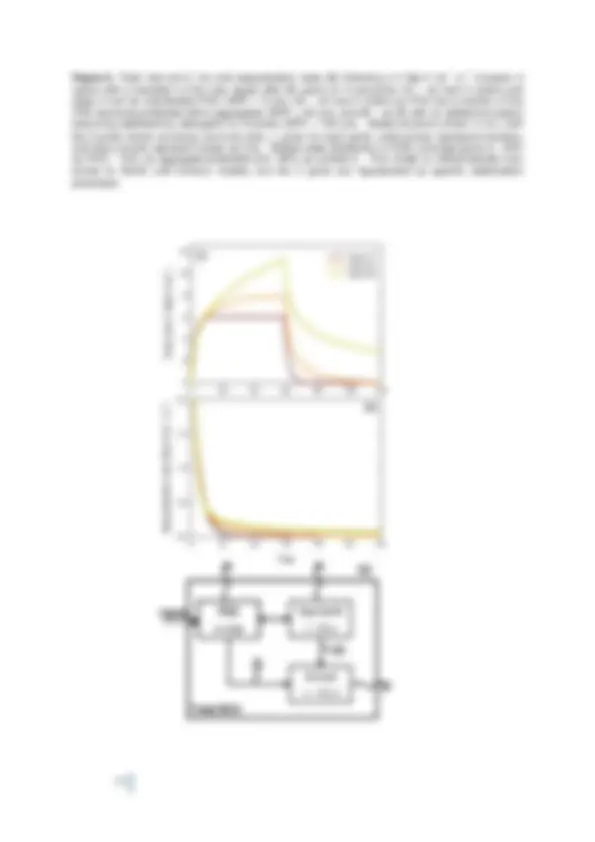

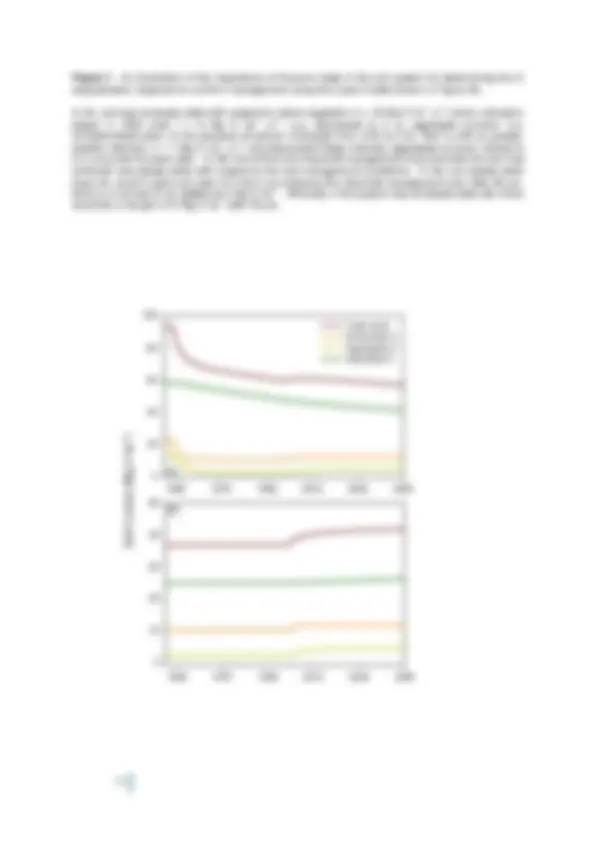
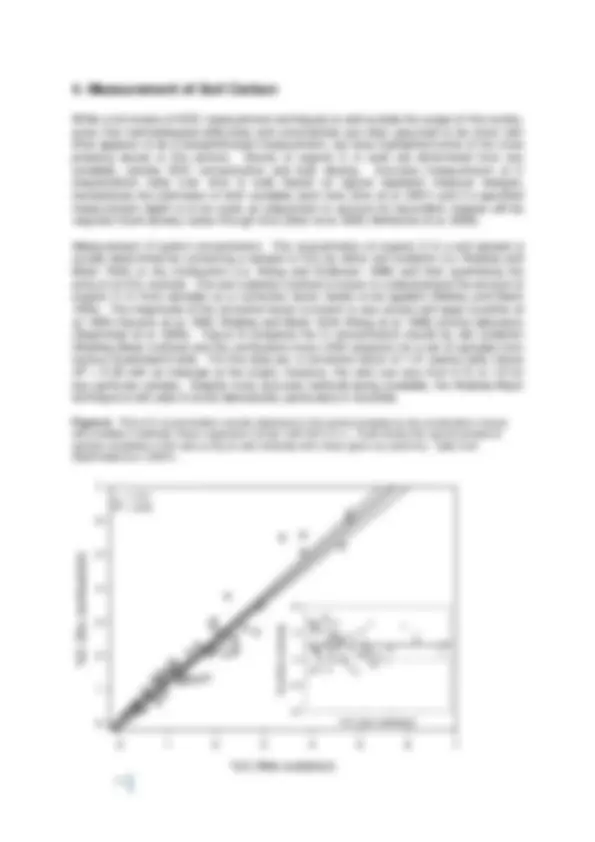

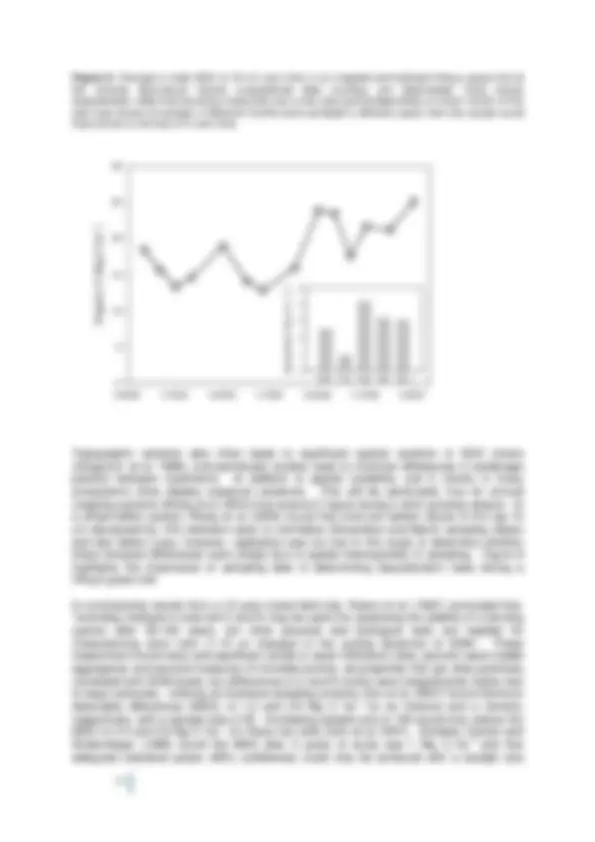

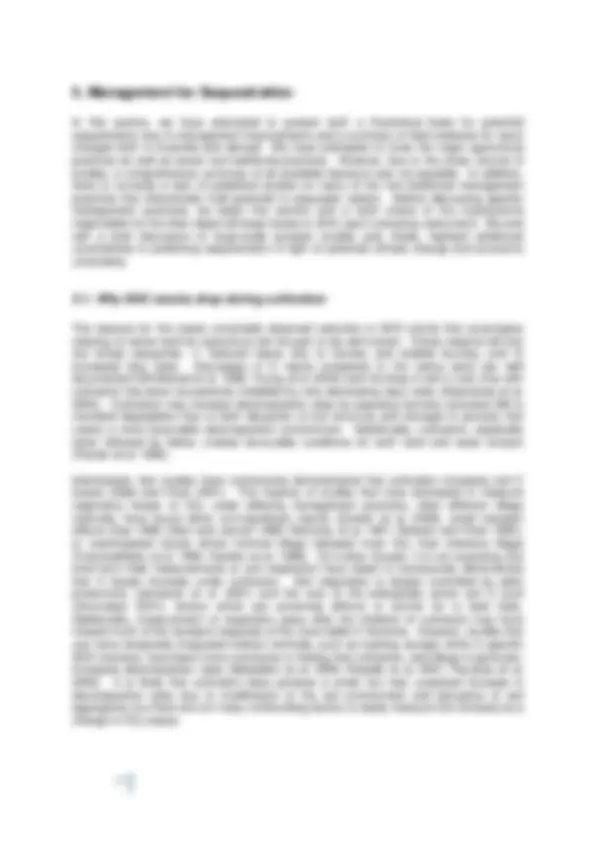
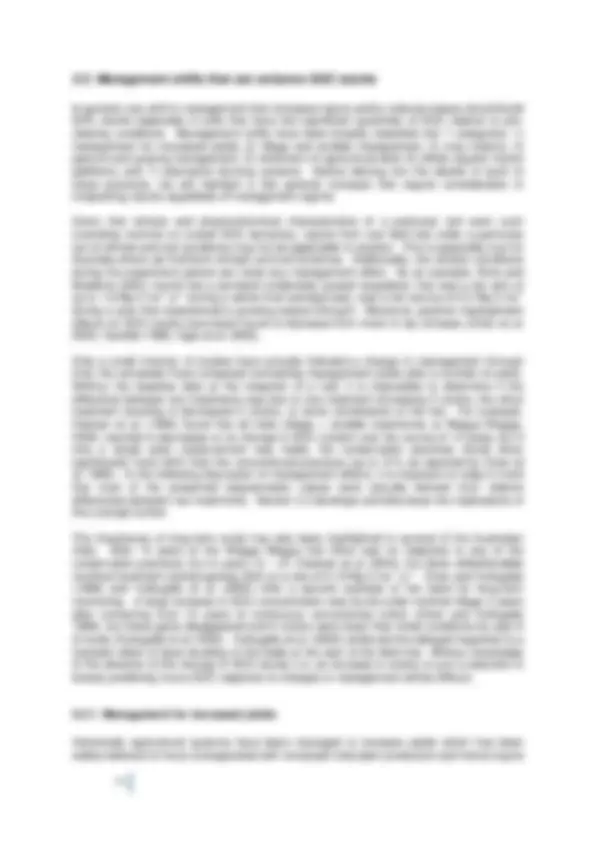



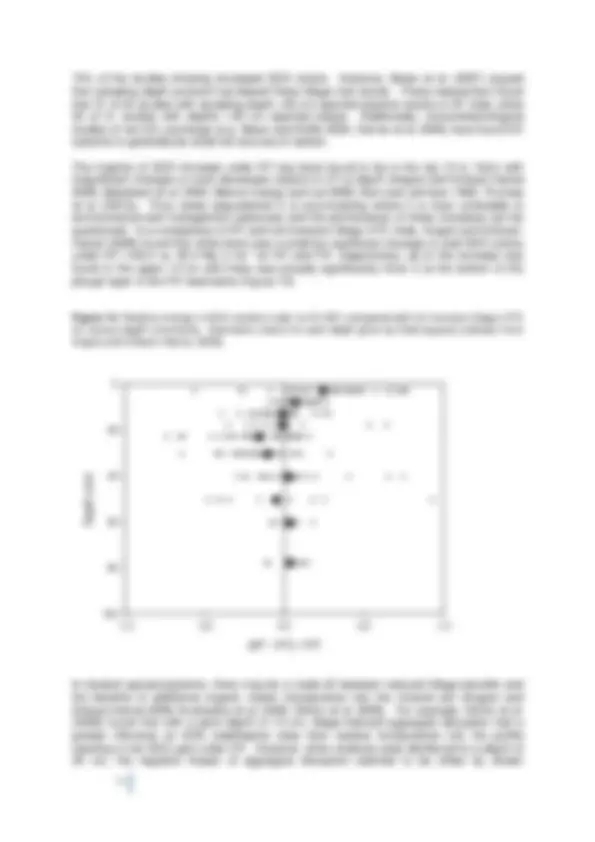
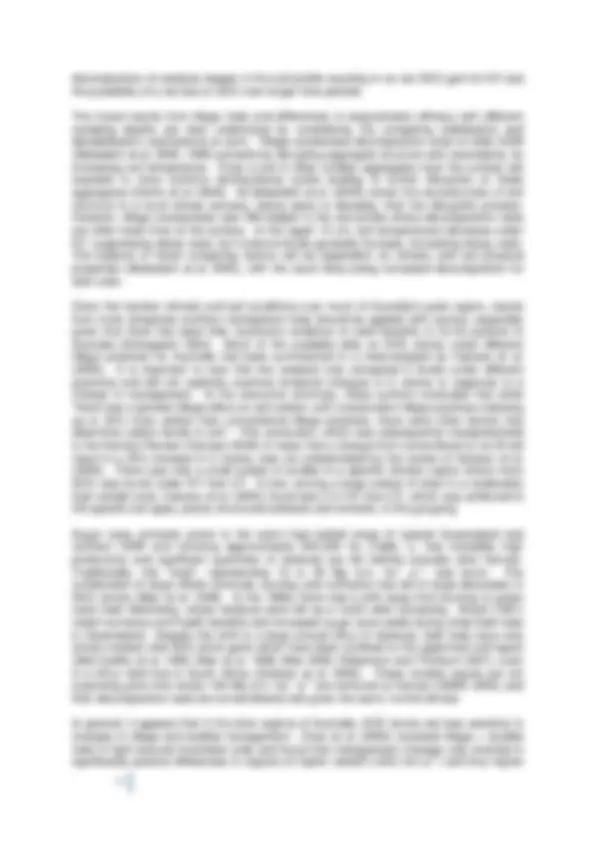
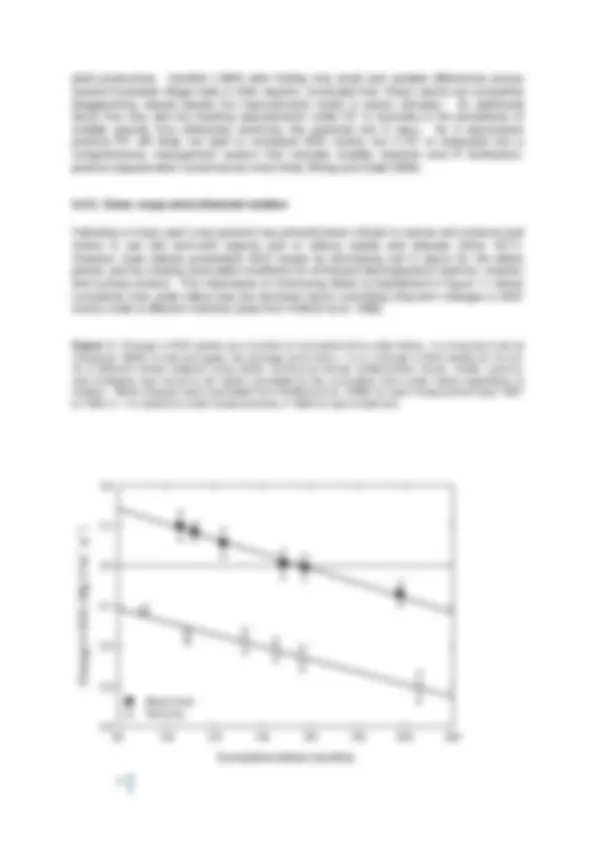


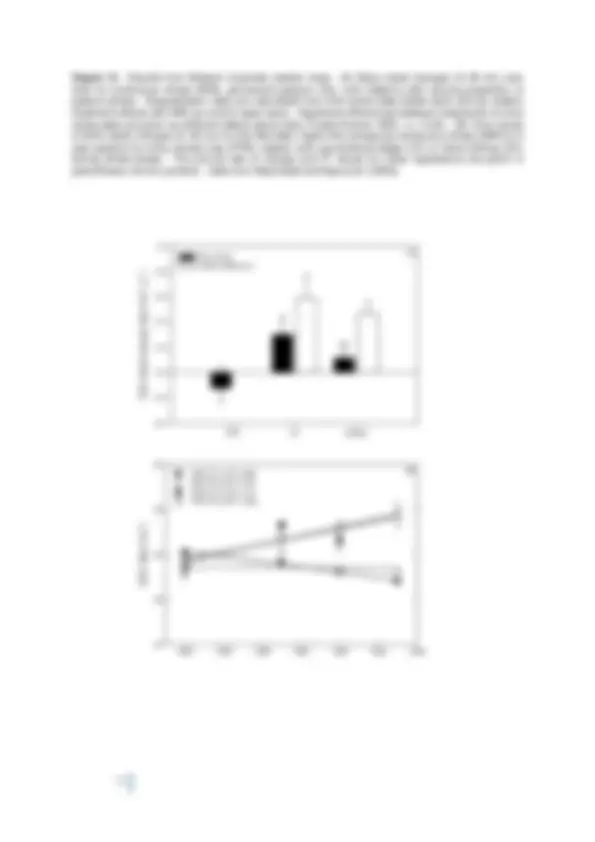


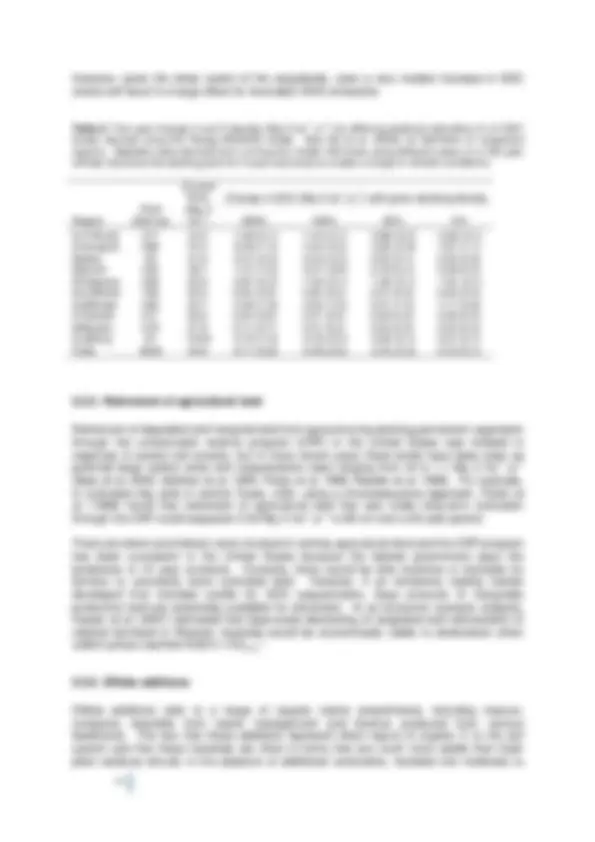

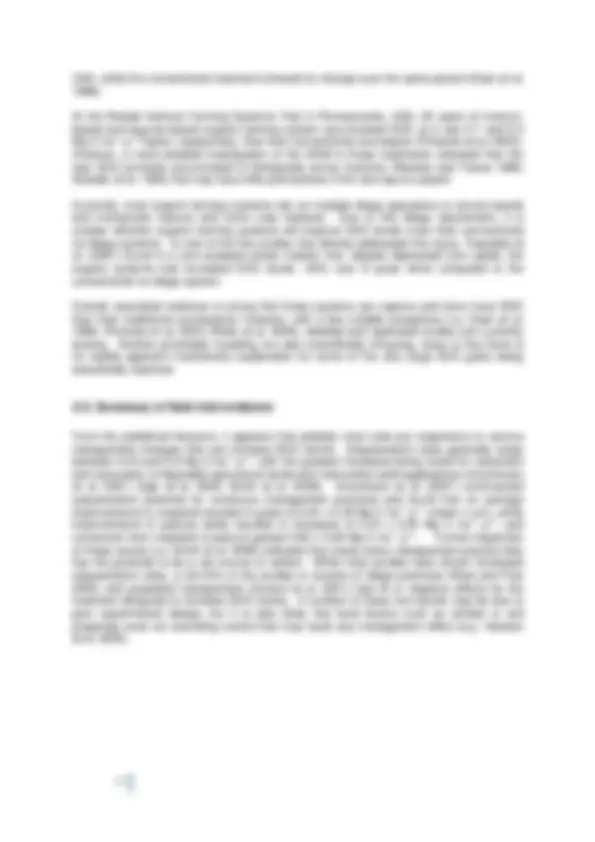
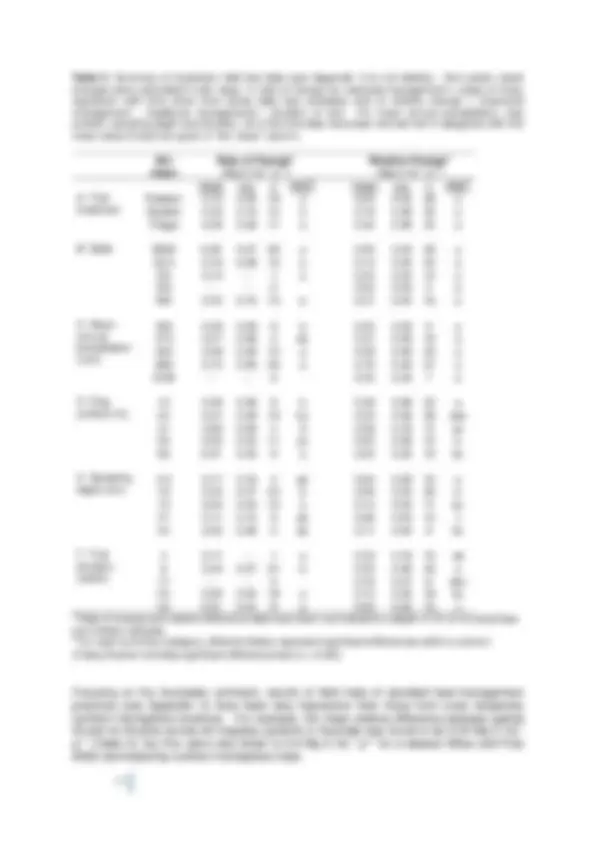
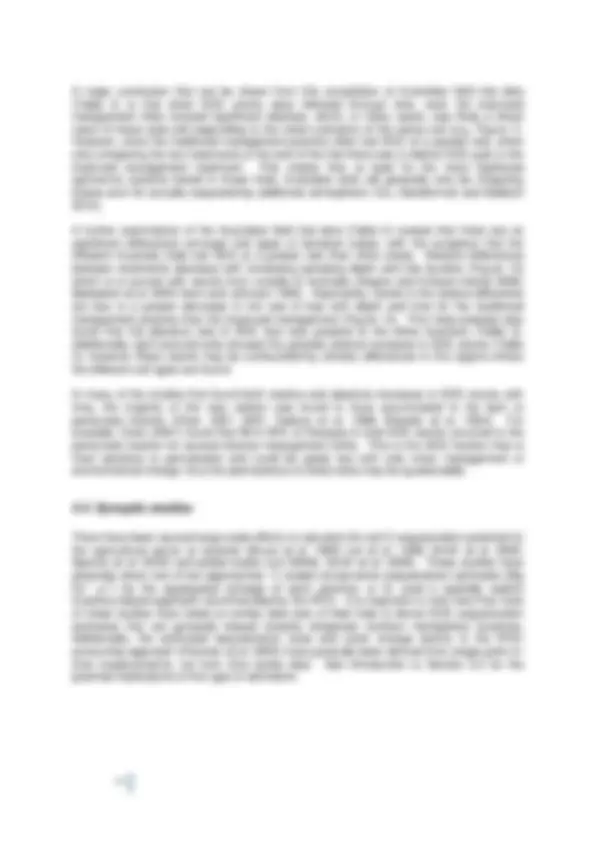
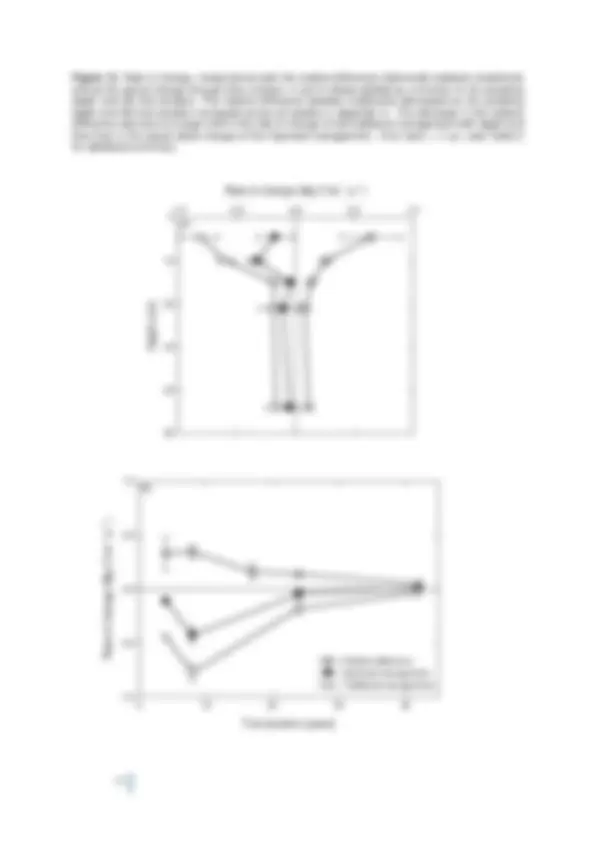
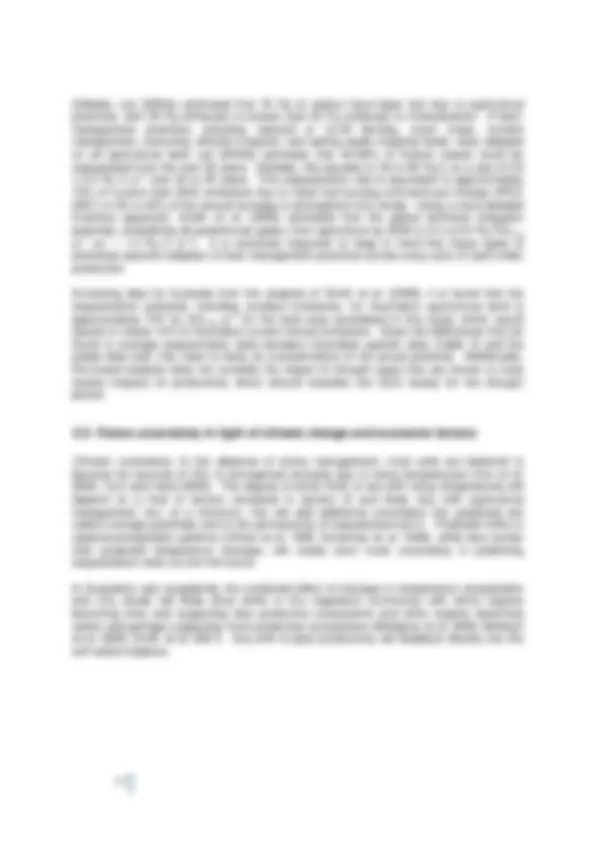
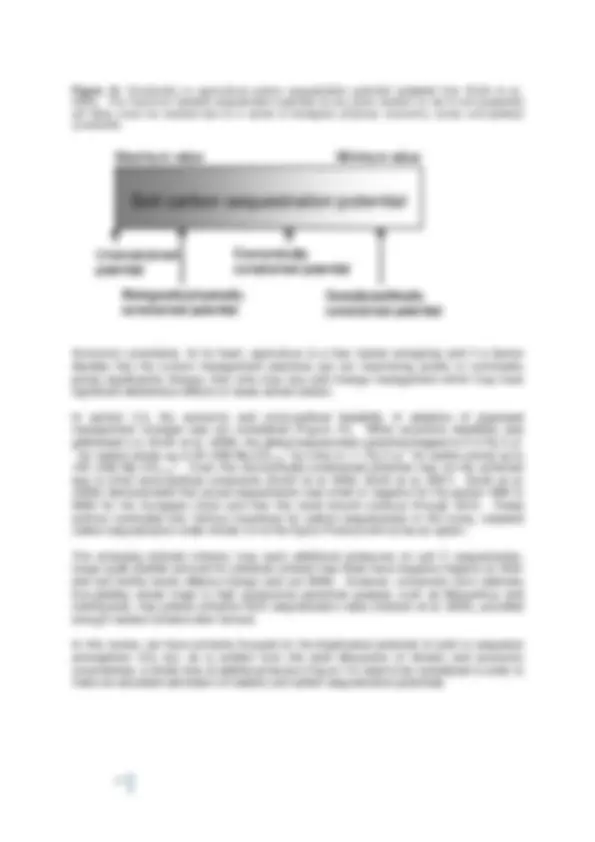
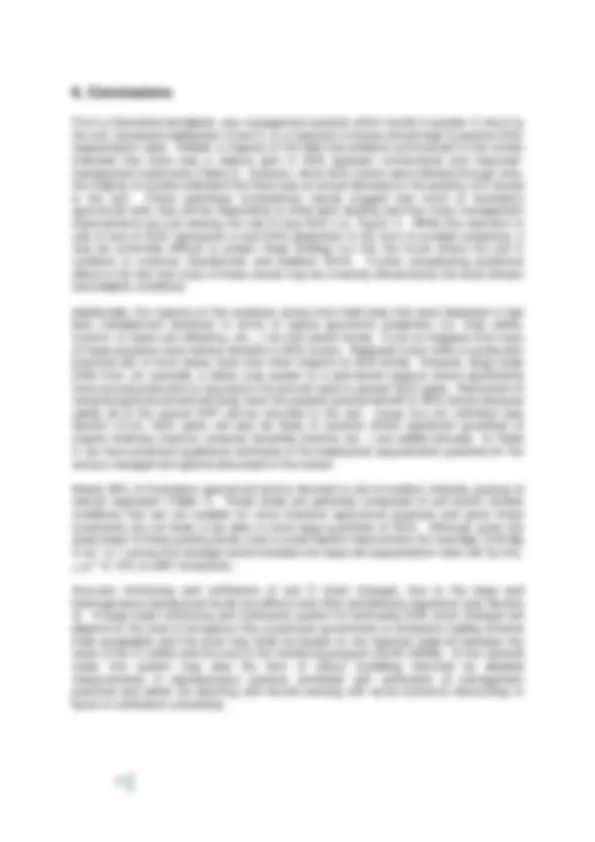
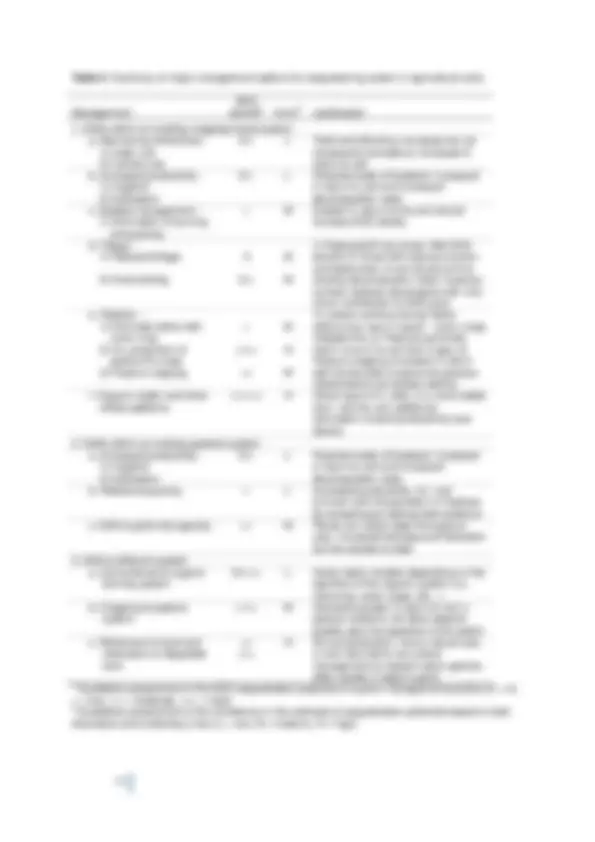

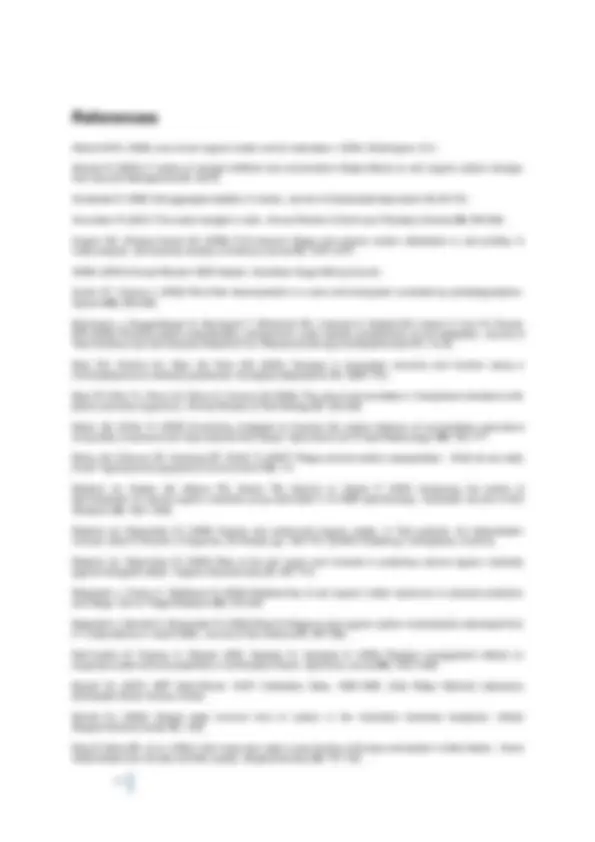
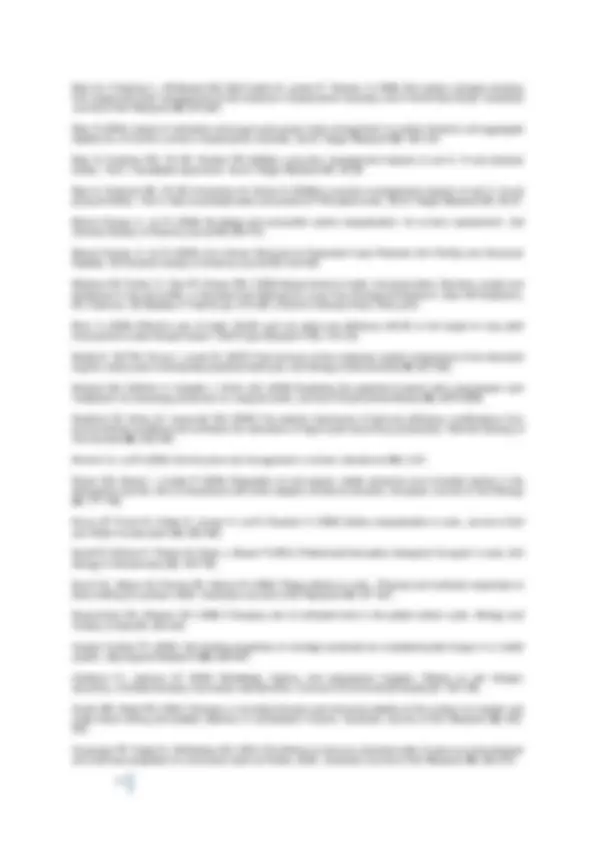




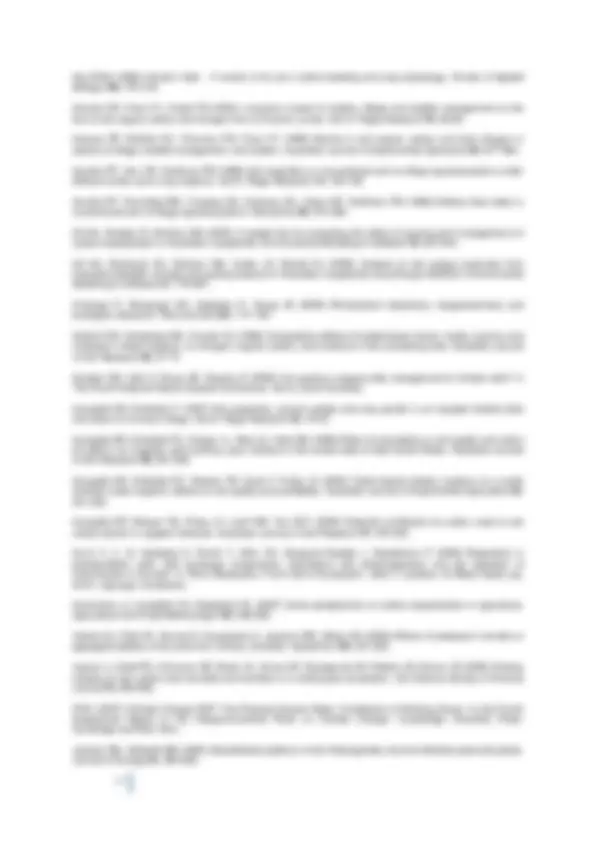






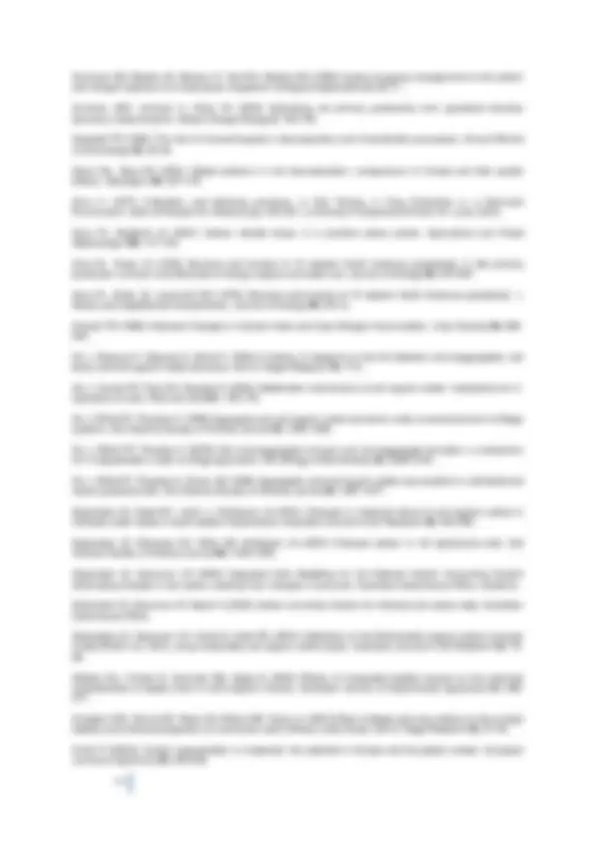





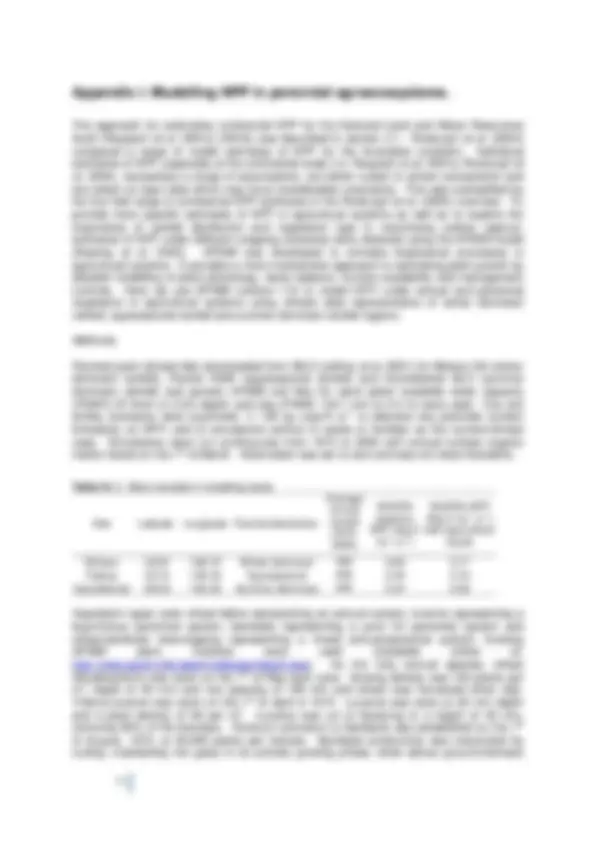
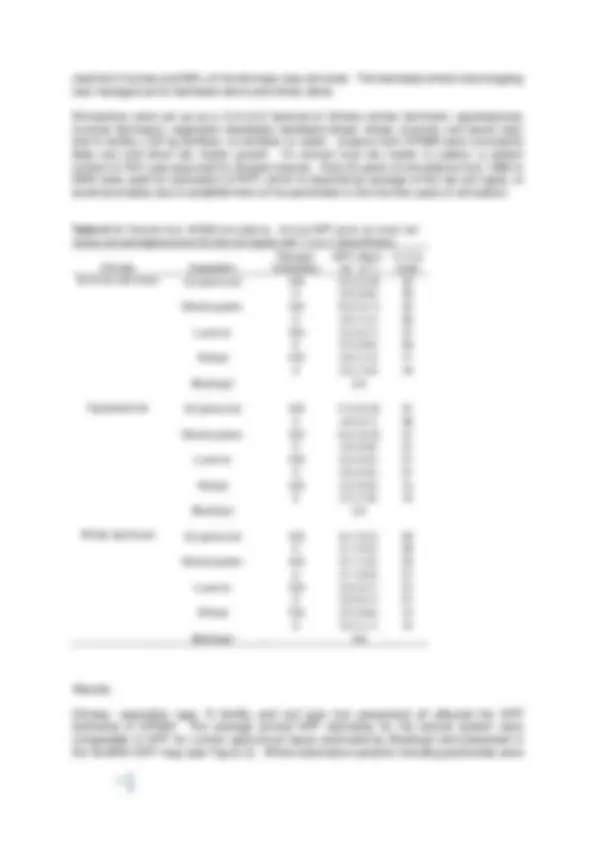

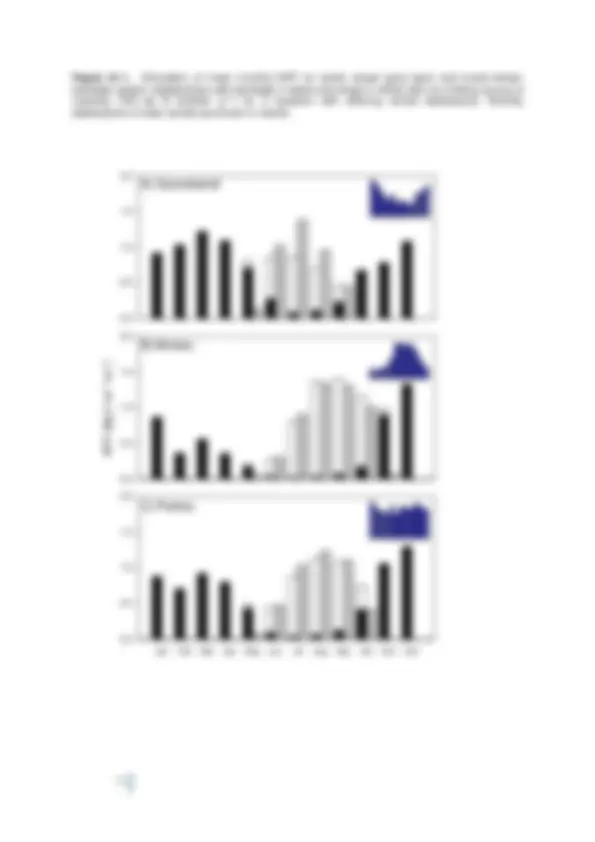
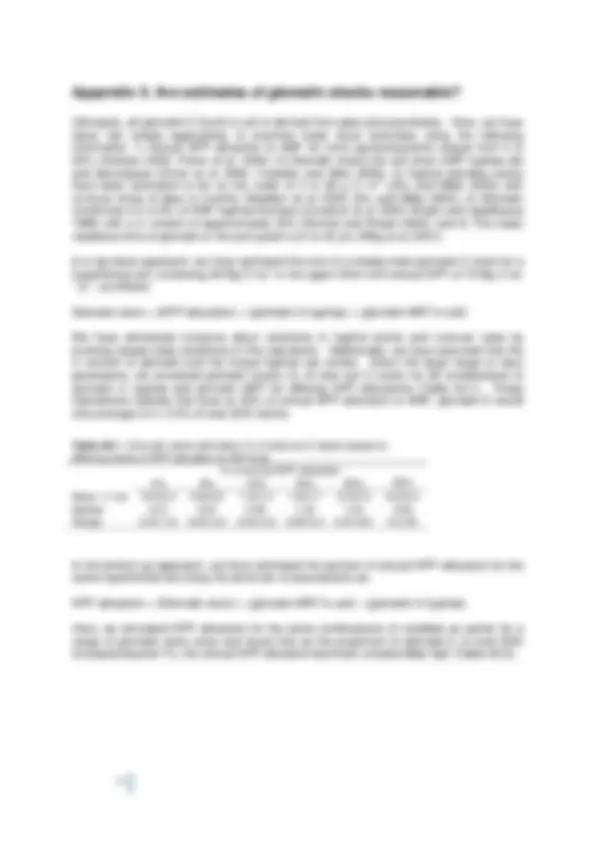

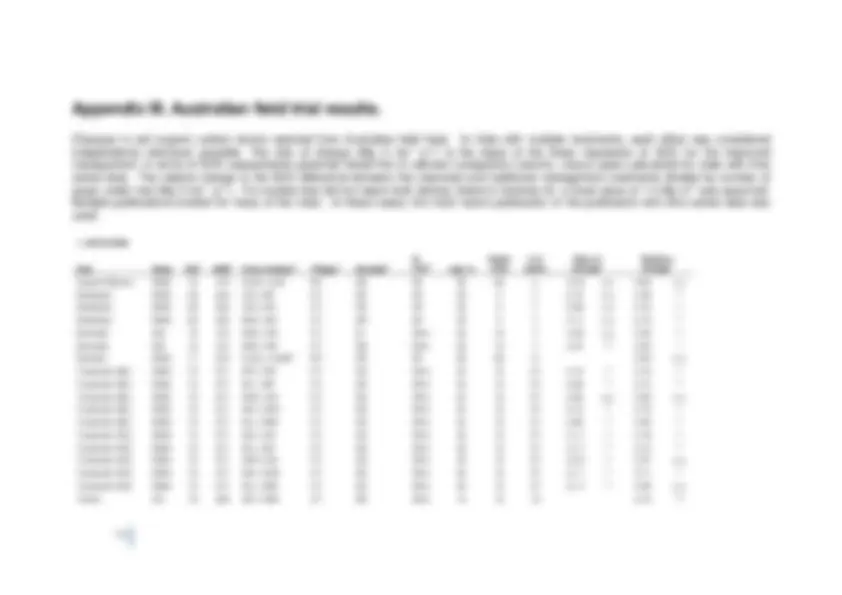







Study with the several resources on Docsity

Earn points by helping other students or get them with a premium plan


Prepare for your exams
Study with the several resources on Docsity

Earn points to download
Earn points by helping other students or get them with a premium plan
Community
Ask the community for help and clear up your study doubts
Discover the best universities in your country according to Docsity users
Free resources
Download our free guides on studying techniques, anxiety management strategies, and thesis advice from Docsity tutors
The current scientific understanding of soil organic carbon (soc) accumulation and loss, with a focus on the australian context. It covers factors influencing soc, such as carbon inputs, fate of captured carbon, and the role of biochemically recalcitrant compounds. The document also explores the impact of management practices like tillage, grazing, and the introduction of perennial grasses on soc.
Typology: Study notes
1 / 89

This page cannot be seen from the preview
Don't miss anything!


















































































CSIRO Land and Water
ii
Acknowledgements
This report was supported through a funding contribution from the Department of Climate Change and Energy Efficiency, Australian Government.
We are indebted to numerous researchers for input to this report. We would like to particularly thank Michael Raupach for fruitful discussions on NPP limitations and supplying the NPP maps; Anthony Whitbread for help with the APSIM modelling; and Bill Slattery and Elizabeth Schmidt for thorough and thoughtful reviews of this report.
iv
Executive Summary
Conversion of native land for agriculture has typically resulted in decreases in soil organic carbon (SOC) stocks on the order of 40 to 60% from pre-clearing levels. Globally, this loss of SOC has resulted in the emission of at least 150 Pentagrams (Pg) of carbon dioxide to the atmosphere (1 Pentagram = 1 Gigatonne = 10^15 grams). Recapturing even a small fraction of these legacy emissions through improved land management would represent a significant greenhouse gas emissions reduction.
Currently, there is much uncertainty and debate, particularly within Australia, as to the total potential of agricultural soils to store additional carbon, the rate at which soils can accumulate carbon, the permanence of this sink, and how best to monitor changes in SOC stocks. To help clarify some of these issues, this report presents both a review of the mechanisms of carbon capture and storage in agricultural soils and an analysis of the published evidence for SOC stock changes resulting from shifts in agricultural management.
On average, improved management of cropland, whether enhanced rotation, adoption of no-till or stubble retention, has resulted in a relative gain of 0.2 – 0.3 Mg C ha-1^ yr-1^ compared to conventional management across a range of Australian soils. However, when time series data was available, even the improved management often showed significant absolute declines in SOC stocks, which, in many cases, was likely a direct result of these soils still responding to the initial cultivation of the native soil. Since the traditional management practice often lost SOC at a greater rate, when only comparing the two treatments at the end of the trial there was a relative SOC gain in the improved management treatment. This means that, for the more traditional agronomic systems tested in these trials, Australian soils may only be mitigating losses and not actually sequestering additional atmospheric carbon. Additionally, sequestration rates were found to diminish with increasing trial duration. The largest gains were generally found within the first 5 to 10 years with the rate of change diminishing to nearly 0 after 40 years.
While there was much less field evidence, the data at hand indicates that pasture improvements, including fertilisation, liming, irrigation and sowing of more productive grass varieties, generally have resulted in relative gains of 0.1 – 0.3 Mg C ha-1^ yr-1. Larger gains of 0.3 – 0.6 Mg C ha-1^ yr-1^ have been found for conversion of cultivated land to permanent pasture.
The majority of available field data comes from a fairly narrow range of management options for the dominant agricultural systems of Australia and little data exists on numerous management options which hold potential to sequester large quantities of SOC. Within an existing agricultural system, the greatest theoretical potential for C sequestration will likely come from large additions of organic materials (manure, green wastes, etc…), maximizing pasture phases in mixed cropping systems and shifting from annual to perennial species in permanent pastures. Perhaps the greatest gains can be expected from more radical management shifts such as conversion from cropping to permanent pasture and retirement and restoration of degraded land. These options are summarized in the accompanying table.
Many of these management options that may increase SOC tend to also increase overall farm productivity, profitability and sustainability, and as such are being rapidly adopted in various regions of Australia. However, numerous other management shifts (for example, converting from annual crops to pastures) which may have the
v
greatest positive impact on SOC stocks will likely need incentives, either in the form of direct government subsidies or credits from an emissions trading market, before wide-scale adoption is seen.
There is a strong theoretical basis partially supported by a limited number of field studies for significant SOC sequestration potential in several Australian agricultural sectors. However, a general lack of research in this area is currently preventing a more quantitative assessment of the carbon sequestration potential of agricultural soils.
Summary of major management options for sequestering carbon in agricultural soils
Management
SOC benefita^ Conf.b^ Justification
0/+ L Yield and efficiency increases do not necessarily translate to increased C return to soil b. Increased productivity -
0/+ L Potential trade-off between increased C return to soil and increased decomposition rates c. Stubble management –
Reduced tillage
Direct drilling
0
0/+
M
M
+/++
++
M
H
M
++/+++ H Direct input of C, often in a more stable form, into the soil; additional stimulation of plant productivity (see above)
0/+ L Potential trade-off between increased C return to soil and increased decomposition rates b. Rotational grazing + L Increased productivity, inc. root turnover and incorporation of residues by trampling but lacking field evidence c. Shift to perennial species ++ M Plants can utilize water throughout year, increased belowground allocation but few studies to date
0/+/++ L Likely highly variable depending on the specifics of the organic system (i.e. manuring, cover crops, etc…) b. Cropping to pasture system
+/++ M Generally greater C return to soil in pasture systems; will likely depend greatly upon the specifics of the switch c. Retirement of land and restoration of degraded land
++ +++
H Annual production, minus natural loss, is now returned to soil; active management to replant native species often results in large
a C gains Qualitative assessment of the SOC sequestration potential of a given management practice (0 = nil, + = low, ++ = moderate, +++ = high) b Qualitative assessment of the confidence in this estimate of sequestration potential based on both theoretical and evidentiary lines (L = low, M = medium, H = high)
vii
List of Figures
Figure 1 Carbon flow in agro ecosystems……………………………………… ……... 6
Figure 2 Estimates of spatial distribution of NPP for the Australian continent from 12 different modelling exercises……………………………………………………………… 8
Figure 3 A hierarchical model of the dominant factors controlling many soil processes in terrestrial ecosystems………………………………………………………………….. 16
Figure 4 Soil respiration versus temperature in an annual winter-rain dominated grassland when the soil is dry and wet…………………………………………………. 17
Figure 5 Drop in soil C upon cultivation of soils with varying texture………………... 18
Figure 6 Total new soil C (A) and sequestration rates (B) following a 2 Mg C ha-1^ yr- increase in inputs with a cessation of the new inputs after 60 years for 3 scenarios.
Figure 7 An illustration of the importance of the prior state of the soil system for determining the C sequestration response to a shift in management……………….. 22
Figure 8 Plot of C concentration results obtained on the same samples by dry combustion versus wet oxidation methods…………………………………………….. 23
Figure 9 Changes in total SOC to 10 cm over time in an irrigated and fertilized Kikuyu grass trial at the Urrbrae Agricultural Centre.………………………………………….. 25
Figure 10 Relative change in SOC content under no-till (NT) compared with full- inversion tillage (FIT) for various depth increments…………………………………… 32
Figure 11 Change in SOC stocks as a function of cumulative time under fallow….. 34
Figure 12 Results from Western Australia rotation trials……………………………… 37
Figure 13 Rate of change in soil C stocks plotted as a function of (A) sampling depth and (B) trial duration………………………………………………………………………. 45
Figure 14 Constraints on agricultural carbon sequestration potential……………….. 47
viii
List of Tables
Table 1 National land use 2001/2002 summary………………………………………… 3
Table 2 Five year change in soil C density (Mg C ha-1^ yr-1) for differing stocking intensities (% of current levels) derived using the Range-ASSESS model…………. 40
Table 3 Summary of Australian field trial data…………………………………………. 43
Table 4 Summary of major management options for sequestering carbon in agricultural soils…………………………………………………………………………… 49
2
2. Background
Soils contain large amounts of carbon in both organic and inorganic forms. Organic C is found in soils in the form of various organic compounds, collectively called soil organic matter (SOM). The amount of C found in SOM ranges from 40 to 60% by mass. Strictly speaking, SOM includes all living and non-living organic material in the soil (Baldock and Skjemstad 1999). The living component includes plants, soil fauna and microbial biomass. The non-living component, representing the bulk of SOM, includes a spectrum of material from fresh residues and simple monomeric compounds to highly condensed, irregular polymeric structures with residence times varying from days to millennia.
Globally, the top meter of soil stores approximately 1500 Pg as organic C and an additional 900-1700 Pg as inorganic C and exchanges 60 Pg C yr-1^ with the atmosphere, which contains ~750 Pg C as carbon dioxide (CO 2 ) (Eswaran et al. 1993; Schlesinger 1997). The shear size of the soil carbon pool and the annual flux of carbon passing through the soil are two of the reasons that SOC can play a significant role in mitigating GHG emissions. Currently, there is not enough research on the topic of anthropogenic impacts on the formation and loss of soil inorganic C to be able to assess its sequestration potential and it is only the organic C pool that is under consideration for inclusion in various emission reduction schemes.
Historically, approximately 78 Pg C has been lost from the global soil pool due to land-use conversion for agriculture with approximately 26 Pg attributed to erosion and 52 Pg attributed to mineralization (Lal 2004b). Conversion of native forest and pasture to cropland has been found to reduce SOC stocks by an average of 42% and 59%, respectively (Guo and Gifford 2002). These large historic losses and the concomitant potential to return to pre- clearing SOC conditions are precisely the reason many researchers believe there is great potential for agricultural soils to sequester large amounts of atmospheric CO 2 relative to current SOC levels.
Total soil organic carbon stocks in 1990 for the Australia continent were estimated at 19 Pg for the top 30 cm by Grace et al. (2006) with a natural flux of ~700 Tg CO 2 (cf Barrett 2002) exchanged between the soil and atmosphere every year. This natural exchange is ~12% larger than Australia’s 2007 anthropogenic GHG emissions excluding land use and land-use change (available online at: http://www.climatechange.gov.au/inventory/index.html). At face value, a mere 0.8 % per annum increase in SOC stocks would effectively mitigate Australia’s annual GHG emissions.
The agricultural sector covers approximately 60% of the land area of Australia, with >90% of that area (419 Mha) being used for low-density grazing of natural vegetation (Table 1). This leaves ~50 Mha of land that is actively managed, primarily for grazing of modified pastures and various cropping systems.
3
Table 1. National land use 2001/02 Summary (Bureau of Rural Sciences)
Land use type Area (10^3 ha) % of total Grazing of natural vegetation 419,472 54. Grazing modified pastures 24,107 3. Dryland cereal cropping 19,214 2. Dryland legume cropping 2,348 0. Dryland oil seed cropping 1,522 0. Irrigated cereal cropping 636 0. Horticulture (mostly irrigated) 571 0. Sugarcane (~50:50 dry:irrigated) 559 0. Cotton (primarily irrigated) 482 0. Other crops (dry+irrigated) 180 0.
Agriculture total 469,092 61. Managed ag total 49,620 6. Potentially tilled acreage 24,941 3.
Total land area 768,
Actively managed lands can be divided into 5 broad agroecological zones:
600 mm yr-1).
5
3. Carbon Cycling in Agroecosystems
Before discussing specific management impacts on soil organic carbon stocks (SOC), we feel it is critical to review the current scientific understanding of the factors that govern the accumulation and loss of SOC. In this section, we follow the flow of carbon (Figure 1) as atmospheric CO 2 is fixed during photosynthesis, transferred to the soil as organic carbon, and ultimately returned back to the atmosphere as CO 2 produced during mineralisation of SOC.
Soil organic carbon is initially derived from photosynthetically captured carbon, thus plant productivity sets an absolute upper limit to potential carbon inputs to the soil system. In fact, over large regional areas, primary productivity appears to control the carbon balance of soils (Janssens et al. 2001). In this section, primary productivity is discussed in terms of the capture of light energy by plants and its conversion to chemical energy by photosynthesis, constraints to carbon capture imposed by light, water and nutrients, and carbon losses resulting from respiration. Then, continental-scale estimates of net primary productivity for Australia based on these principles are compared with more mechanistic plant growth modelling approaches. Finally, we briefly discuss agricultural management strategies to maximize carbon capture.
3.1.1. Upper limit of carbon capture
An upper limit for carbon inputs into a system can be defined by the potential conversion of incoming solar energy into chemical energy and metabolic intermediates by plant photosynthesis. Plants use carbon assimilated by photosynthesis for the synthesis of plant structural components and other metabolic requirements. Hence, net primary productivity (NPP) is defined as gross primary productivity (GPP or carbon assimilation) less autotrophic respiration. Estimation of primary productivity at regional scales requires an estimate of photosynthetically active radiation (PAR), the fraction of PAR absorbed by the vegetation (usually informed by a leaf area index), the light-use efficiency of the vegetation, and the amount of autotrophic respiration. Stress functions can be applied to estimates of potential NPP to take into account limitations imposed by nutrient and water availability that result in actual NPP being less than potential NPP. Depending on the approach being taken, these stress functions might be incorporated into the light-use efficiency and respiration terms, or applied separately.
3.1.2. Constraints to capturing carbon
Photosynthetically active radiation. The amount of incident radiation reaching the surface of the planet depends on earth-sun geometry and attenuation in the atmosphere. On average less than half of the solar radiation reaching the outer atmosphere reaches the earth’s surface. The greatest insolation (incoming solar radiation, J m-2) is at the equator and decreases towards the poles. Additionally, downward irradiance will be modified by cloud albedo and is therefore calculated hourly and integrated to give daily insolation totals (for Australia, see http://www.bom.gov.au/sat/solradinfo.shtml). Of the incident solar radiation reaching the canopy, plants can only utilise blue to red visible wavelengths (between approximately 400 and 700 nm) for photosynthesis which on average represents 45% of incoming energy from solar radiation.
6
Figure 1. Carbon flow in agroecosystems. Limitations on carbon capture given in white boxes. Carbon losses given in grey boxes with squiggly lines representing CO 2 losses. Inputs of C to the soil system can be partitioned between above- and belowground components. A fraction of NPP flows through roots to mycorrhizal fungi (AMF). Some C enters the soil as organic compounds excreted by roots and, if present, AMF fungi. The majority of C enters the soil as particulate organic C (POC). Aboveground C enters the soil as dissolved material in water leaching through residue layers or as POC mixed into the soil by soil fauna or tillage. A portion of the above- and belowground C entering the soil is slowly transformed to humus with the remainder being mineralised back to CO 2.
Soil Organic Carbon
Solar radiation
PAR
Potential GPP
Potential NPP
Autotrophic respiration
Water & nutrient limited NPP Plant C losses Product harvest Herbivory
Light-use efficiency Interception, absorption, LAI, albedo, shading, extinction, direct/diffuse light
External inputs Irrigation & Fertilizers
Limitations Water & Nutrients
Earth-sun geometry, cloud cover & albedo
Surface residues
POC Humus
AMF
Carbon inputs to soil system
Roots
Incorporation Mixing & Leaching
Heterotrophic respiration
Erosion
CO 2
Soil Organic Carbon
Solar radiation
PAR
Potential GPP
Potential NPP
Autotrophic respiration
Water & nutrient limited NPP Plant C losses Product harvest Herbivory
Light-use efficiency Interception, absorption, LAI, albedo, shading, extinction, direct/diffuse light
External inputs Irrigation & Fertilizers
Limitations Water & Nutrients
Earth-sun geometry, cloud cover & albedo
Surface residues
POC Humus
AMF
Carbon inputs to soil system
Roots
Incorporation Mixing & Leaching
Heterotrophic respiration
Erosion
CO 2
8
‘bottom up’ approaches involving parameterisation of physiological plant growth models (Keating et al. 2003; Roxburgh et al. 2004). By necessity there are assumptions and simplifications in all approaches that contribute to the variation in NPP estimates_._ As part of the National Land and Water Resources Audit, Raupach et al. (2001a; 2001b) developed a model (BiosEquil) to assemble long-term average or steady state balances of water, carbon, nitrogen and phosphorous. As part of this work, a ‘semi-mechanistic’ expression to calculate NPP at the whole canopy level was developed using a simplified version of leaf scale photosynthetic models and empirical coefficients for the canopy scale. Light and water limited NPP was first calculated using transpiration and incident radiation via a water- and light-use efficiency (from climate data and satellite derived leaf area). Stress functions were then applied for nitrogen and phosphorous limitation to give nutrient limited NPP. Scenarios based on current (with agricultural inputs) and baseline (without agricultural inputs) states were simulated (see Raupach et al. 2001b for further details). The BiosEquil model was calibrated and tested against 184 NPP estimates in the VAST dataset (Barrett 2001). While the poor local skill of the model has been acknowledged, for continental scale NPP the BiosEquil model provided a reasonable indication of potential carbon capture by primary productivity across Australia, and hence inputs of carbon into agroecosystems (map #10 in Figure 2).
Roxburgh et al. (2004) reviewed 12 model estimates of NPP for the Australian continent representing a variety of approaches (Figure 2). The BiosEquil estimate of 0.94 Pg C yr- was at the lower end of the continental NPP estimates and could therefore be considered to be conservative. This may be related to the calibration of the model on the VAST dataset
Figure 2. Estimates of spatial distribution of NPP for the Australian continent from 12 different modelling exercises (from Roxburgh et al. 2004). Long-term average NPP (Pg C yr-1) given in parentheses. Reproduced by permission of CSIRO Publishing.
9
(Barrett 2001) which consisted of NPP observations from minimally disturbed systems assumed to be in steady state. Large variability exists in estimates of total and within continental NPP for Australia and there is a dearth of empirical NPP estimates for model development and validation (Roxburgh et al. 2004). Difficulties in obtaining comprehensive measures of NPP (Clark et al. 2001; Scurlock et al. 2002) contribute to the variability in NPP estimates. However, continental scale NPP estimates still provide a useful indication of the carbon yield across the landscape and hence potential carbon inputs into the soil.
3.1.4. Maximizing NPP
Agronomists have aimed to maximise the productivity of agricultural systems in the interests of profitability. This is usually coupled with the export either of harvestable plant products or livestock production. Whether the drive for profitability has concomitantly increased NPP alongside yield, or simply shifted the partitioning of total production towards harvestable products (by increasing harvest indices and decreasing the allocation of carbon to roots) will have broad implications for the carbon balance of agricultural systems and the ability to increase inputs of carbon to the soil through management.
The most direct way to maximise NPP is to alleviate the limitations to NPP. In most Australian agroecosystems water and nutrients represent the major limitations to NPP. Thus NPP in many agricultural systems is considered to be higher than that of native systems they replaced, in part because of inputs of fertiliser and irrigation (Raupach et al. 2001a). NPP can also be maximised by increasing the efficiency by which the available resources are used (see section 5.2.1).
One strategy that is rapidly gaining in popularity throughout many regions of Australia is to introduce perennial species into systems that are currently dominated by annuals to improve the use of available water in the summer months when light intensities, and thus potential photosynthesis rates, are greatest. Using the APSIM model (Keating et al. 2003), we found that there is theoretical potential to increase productivity by better utilisation of rain falling outside the typical annual cropping cycle by perennial grass. Modelling scenarios suggested that NPP could be doubled or even tripled under perennial grasses relative to winter cereal/summer fallow systems depending on rainfall distribution (see Appendix 1).
In summary, an understanding of the maximum carbon capture under different agricultural scenarios will set a theoretical upper limit to soil C inputs and thus soil sequestration potential. However, as highlighted earlier, there isn’t necessarily a direct 1:1 relationship between gains in productivity and gains in C inputs to the soil, so predicting sequestration rates from productivity increases alone will likely not be possible.
The fate of recently fixed carbon, whether it stays on the land or is exported as a farm commodity, and its mode of incorporation into the soil are two of the dominant factors controlling soil carbon stocks. On any given area of land, some quantity of carbon will be fixed from the atmosphere that will depend on the environmental and phenotypic factors outlined in the previous section. In agroecosystems, a substantial portion of this fixed C will be removed during harvest, with 30 – 50% of aboveground dry mass typically being removed for most modern cereal crops (Hay 1995; Johnson et al. 2006; Unkovich et al. 2009). Following harvest, the remainder of the annual fixed C will reside as aboveground residues, belowground residues (i.e. root biomass), or have already been transferred into the soil as root and mycorrhizal exudates (including turnover of short-lived fine roots and fungal hyphae). In perennial systems, such as pastures, there is a constant, although often
11
soybean and lupin, Gregory (1994; 1996) found that root-to-shoot ratios decreased from about 0.4 to 0.6 during vegetative growth phases to as low as 0.1 at flowering. Low root-to- shoot ratios for cash crops are not surprising since these crops have been intensively bred to maximize grain yields.
Longer-lived species, such as perennial grasses, invest significantly more resources into maintaining a healthy root system resulting in substantially higher root-to-shoot ratios. In a typical New Zealand pasture, Stewart and Metherell (1999) found root-to-shoot ratios ranging from 1.1 to 2.3 depending on season and management. For mixed-grass prairies in the northern Great Plains of the United States with various grazing pressure, Schuman et al. (1999) found 5 to 11 times more biomass in roots than in all aboveground biomass, with the highest values reported for the most intensively grazed site. Root-to-shoot ratios were found to increase with decreasing water availability from a range of 3-5 to 18-25 as the grassland community shifted from tallgrass to shortgrass prairie along a west-to-east transect across the Great Plains (Derner et al. 2006; Sims et al. 1978), which Derner et al. (2006) attributed to enhanced root production in a water-limited environment.
In perennial systems, the reality of a standing stock of roots that persists year after year poses a challenge that is not faced in annual crop systems to modelling soil C inputs using the root-to-shoot ratio. Direct estimation of annual belowground NPP (BNPP) would be much more helpful. Gill et al. (2002) derived a simple algorithm for estimating BNPP that considered the proportion of live roots to total biomass and the root turnover rate. These authors found that BNPP was only 35 to 52% of measured belowground biomass for conditions typical of Australia. This calculation suggests that standing biomass in longer- lived species, both aboveground and belowground, may not be very representative of C inputs to the soil.
3.2.1. Rhizodeposition
Rhizodeposition describes all carbon loss from roots including lysates, sloughed cells, insoluble mucilages and mucigels, and water-soluble low-molecular weight exudates and secretions (Whipps and Lynch 1983). In total, these various rhizodeposits represent a significant C drain to plants, accounting for up to 40% of NPP under highly stressed conditions (Lynch and Whipps 1990), but more typical values range from 7 to 15% (Swinnen et al. 1995) with an average around 17% (Nguyen 2003). These numbers, however, should be viewed with some caution due to the difficulty in making these measurements (Rees et al. 2005).
There are numerous reasons for this high C flow from roots to the soil. A large portion of rhizodeposits are the indirect result of root growth and turnover, while a smaller, but ecologically significant, fraction are actively exuded and secreted by living cells. These exudates are now known to play active roles in plant-to-plant and plant-to-microbe signalling and in micronutrient acquisition via the stimulation of microbial communities (Bais et al. 2006).
Root exudates probably do not directly contribute much to soil C stocks. Boddy et al. (2007) found that these low-molecular weight exudates had half-lives of only 20 to 40 minutes in soil. If anything, root exudates contribute to the depletion of SOC stocks due to what has been termed the ‘rhizosphere priming effect’. Rates of overall SOC decomposition have been shown to increase 3 to 5 fold in response to root exudates (Cheng et al. 1993; Dijkstra and Cheng 2007; Kuzyakov 2002). However, longer lived, more complex substrates derived from root turnover are likely to make significant contributions to SOC stocks due to both their
12
inherent biochemical resistance to decomposition and through indirect effects these compounds have on soil aggregation (Rees et al. 2005).
3.2.2. Mycorrhizal fungi and glomalin
Associations between plant roots and arbuscular mycorrhizal fungi (AMF) are ubiquitous in agroecosytems (Treseder and Cross 2006). Estimates of the amount of C allocated to fungal associates range from 4 to 20% of NPP (Graham 2000) with a large fraction of this C supporting the growth of new hyphae which have been estimated to have a turnover rate of days (Staddon et al. 2003) to months (Olsson and Johnson 2005). While the direct contributions to C stocks from hyphal turnover appears small (Zhu and Miller 2003), the indirect effects that hyphal growth has on soil structure and aggregate stability can have significant impacts on total SOC stocks (Miller and Jastrow 1990; Oades and Waters 1991) which will be discussed in subsequent sections.
Researchers have identified a glycoprotein-like substance, termed glomalin, which is produced by AMF hyphae (Driver et al. 2005; Wright and Upadhyaya 1996) and is found in significant quantities in most soils (Treseder and Turner 2007). The relatively high abundance of this glomalin-related soil protein (GRSP) is likely due to its slow decomposition rate (Rillig 2004; Rillig et al. 2001). The term, glomalin-related soil protein or GRSP, is used here because glomalin cannot be directly isolated and quantified in soil. Rather, GRSP is operationally defined by extraction procedures and detection by immunoreactivity assay (for detailed discussion of isolation and detection procedures see Rosier et al. 2006; Wright and Upadhyaya 1996; Treseder and Turner 2007) with different procedures producing differing quantities of GRSP especially in OM-rich soils where humic acids may be co-extracted (i.e. Rosier et al. 2006; Schindler et al. 2007).
Total GRSP has been reported to range from 4 to 8% of total organic C stocks across a range of soil and land-use types (Rillig et al. 2003; Rillig 2004), with one estimate as high as 22 to 27% (Nichols and Wright 2004). However, more conservative values in the range of 0.7 to 2.4% appear more common for agroecosystems (Table 1 of Treseder and Turner 2007). Given the current understanding of glomalin dynamics in soils, simple calculations suggest that values much above 2% of total C stocks are unreasonable based on the proportion of annual NPP that would be needed to support AMF hyphal growth (see Appendix 2). These calculations support the conclusions of Rosier et al. (2006) and Schindler et al. (2007) that certain GRSP extraction procedures are likely isolating more than just glomalin.
Regardless of the absolute accuracy of GRSP stock estimates, the majority of scientific evidence indicates that this substance is present in measurable but modest quantities in most soils and, more importantly, due to its biochemical properties, plays a substantial indirect role in C stabilization via soil aggregation (Wright et al. 1999; Wright and Upadhyaya 1996).
Ultimately, the ability for any given soil system to sequester carbon lies in the balance between net inputs, described previously, and net losses. Microbial decomposition and mineralisation to CO 2 , is the dominant fate of organic carbon in the great majority of soils. In arid and semiarid systems, such as commonly found in Australia, photodegradation of surface litter also plays an important role (Austin and Vivanco 2006; Moorhead and Callaghan 1994). Austin and Vivanco (2006) found that blocking UV-light doubled the mean